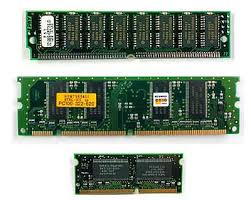Computer Memory -
Dhan Bahadur Thapa
Computer Memory
is the most essential part of the computer system. It is used as mass storage
device as well as the work place processor. Generally memory is used to store
data programs result of operation and many more. In computing, memory refers to the physical devices used to store programs (sequences of instructions) or data (e.g. program state information) on a temporary or permanent basis for use in a computer or other digital electronic device. The term primary memory is used for the information in physical systems which function at high-speed (i.e. RAM), as a distinction from secondary memory, which are physical devices for program and data storage which are slow to access but offer higher memory capacity. Primary memory stored on secondary memory is called "virtual memory". An archaic synonym for memory is store.
Computer memory can be
classified into two types.
1)
Primary Memory
(Main Memory)
2)
Secondary
Memory ( Auxiliary Memory)
1)
Main Memory
-
Main memory is the semiconductor and is very
faster than secondary memory. Also main memory consumes less power than
secondary memory. But primary memory is expensive than secondary memory.
The main memory of the computer is also known as RAM,
standing for Random Access Memory. It is constructed from integrated
circuits and needs to have electrical power in order to maintain its
information. When power is lost, the information is lost too! It can
be directly accessed by the CPU. The access time to read or write any
particular byte are independent of whereabouts in the memory that byte
is, and currently is approximately 50 nanoseconds (a thousand
millionth of a second). This is
broadly comparable with the speed at which the CPU will need to access
data. Main memory is expensive compared to external memory so it has
limited capacity. The capacity available for a given price is
increasing all the time.
For example many home Personal Computers now
have a capacity of 16
megabytes (million bytes), while 64 megabytes is commonplace on commercial
workstations. The CPU will normally transfer data to and from the
main memory in groups of two, four or eight bytes, even if the
operation it is undertaking only requires a single byte.
2)
Auxiliary Memory]
-
It is the storage device can store large amount
of data and information permanently. It may of three types.
i)
Read Only Memory
ii)
Read Mostly Memory
iii)
Read/Write Memory
1) Main Memory
-
Main memory consists of random access memory (RAM)
and Read only memory. The access method for both these memories is random that
is any memory location can be accessed wherever required. We cannot write data
on TOM but we can write to RAM easily. RAM is a read / writes memory. RAM is
called volatile memory because it continuous data and information till the
power is ON. Similar ROM is call non-volatile memory because it contains data
and information even if power is off.
-
Three types of main memory are explained below.
i)
RAM
(Read/Write)
-
It stands for Random Access memory which is used
by processor or all the time. So it is the main work place of the computer. RAM
can load any program that is to be executed data that is to be operated and the
result of the operation. This storage device because program and data will
remain in RAM as long as the computer has electrical power. So it called
volatile memory. It is of tow types.
a)
Dynamic RAM (DRAM)
b)
Static RAM (SRAM)
a)
Dynamic RAM: dynamic RAM is the type of memory
in modern computer; the main advantage of DRAM is that it is dense meaning that
we can pack a lot of bits into a very small chip. It is also cheaper than SRAM.
The main disadvantage of DRAM is that it must be constantly refreshed otherwise
data will be lost. E.g. DDR1, DDR2, DDR3 etc.
b)
Static RAM (SRAM): SRAM does not need periodic
refresh like DRAM. It is much faster than DRAM. Transistors are used instead of
capacitor in SRAM transistor do not lose their change so refreshing is not
necessary.
ii)
Read
only memory (ROM)
-
ROM stands for read only memory. It only performs
read operation but not write operation. It stores data and information
permanently. It is also called nonvolatile memory because any data stored in
ROM will remain even if power off.
a)
Masked ROM
b)
PROM (Program Read only memory)
iii)
Read
mostly Memory
-
Read mostly memory are actually ROM that can be
reprogrammed later to modify the program that already stored in it. That are
used where reading is frequently done and writing is very rare. It is of
following types.
a)
EPROM
b)
EEPROM
c)
flash memory
·
Cache
memory
-
Cache memory: it is a type of memory that is
placed between CPU and main memory. It is a semiconductor memory and speed
memory used to increase the speed of the processor cache holds the important
and frequently used parts of instruction and data and it can provide to CPU at
a faster rate.
2) Auxiliary Memory
-
It is also known as secondary memory. It stores
data and information for future use. Secondary memory is called permanent
because it stores data had instruction till the data and instruction in it are
not deleted. The memory that supplement to main memory is called secondary
memory. The common auxiliary device used in computer are CD-ROM, CD-RW, DVD,
magmatic Tape, Hard Disk etc. secondary memory are slower and cheaper than main
memory . They have higher storage capacity than main memory.
No comments:
Post a Comment